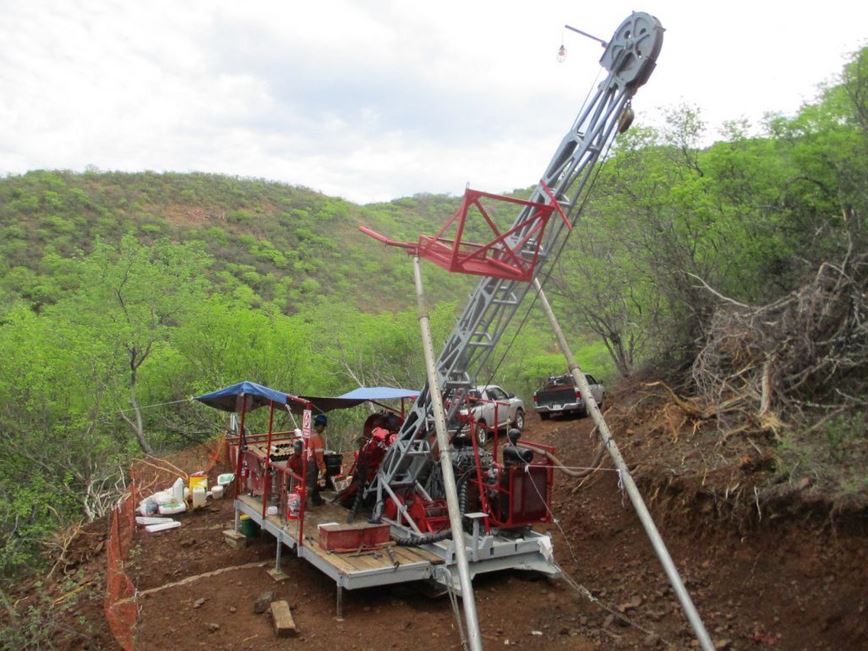Canuc Resources Corporation Announces First Drill Results at San Javier

 Canuc Resources Corporation announces initial results from the Phase I drill program being conducted on the Company’s San Javier Silver-Gold Project in Sonora State, Mexico. A total of 7 holes have been drilled, testing the Santa Rosa vein (SRV) over a strike length of 430 m northeast-southwest. The SRV has been confirmed in all holes for a current strike length of 430 m and is open to the northeast, southwest and at depth.
Canuc Resources Corporation announces initial results from the Phase I drill program being conducted on the Company’s San Javier Silver-Gold Project in Sonora State, Mexico. A total of 7 holes have been drilled, testing the Santa Rosa vein (SRV) over a strike length of 430 m northeast-southwest. The SRV has been confirmed in all holes for a current strike length of 430 m and is open to the northeast, southwest and at depth.
Most assays are still pending. Drill hole SJ17-001 intersected the SRV between 161.35 m and 165.70 m depth, yielding a weighted average of 202 g/t Ag, 0.57 g/t Au, 2.66% Pb and 2.57% Zn over 4.35 m. The SRV, and associated hydrothermal breccias, occur within porphyritic, andesitic volcanics. The volcanics are host to epithermal-style sulphide mineralization and late-stage, low temperature quartz +/- barite veining. Narrow, isolated veins occur in various locations above the SRV, yielding values ranging up to: 14.6 g/t Au, 2.45% Zn; 1.15 g/t Au, 368 g/t Ag, 8.97 % Pb, 10.0% Zn; and 1.17 g/t Au, 908 g/t Ag, 2.28% Pb, 3.46% Zn.
Hole SJ17-004, collared 245 m west of SJ17-001, intersected the SRV and breccias between 69.55 m and 80.0 m depth. It manifests as an upper silver-rich zone that averages 326 g/t Ag over 3.32 m, and a lower gold-rich level that averages 1.74 g/t Au over 6.0 m, including 4.24 g/t Au over 2.0 m. The lower zone also contains a 3.15 m interval that averages 1.25% Zn.
A new, high grade vein was intersected halfway down drill hole SJ17-004 with two splays yielding >1,000 g/t Ag, 3.83 g/t Au, 8.20% Pb, 4.28% Zn and 270 g/t Ag, 1.79 g/t Au, 2.09% Pb, 0.80% Zn over 1.0 and 0.8 meters, respectively. The final result of the >1,000 g/t Ag interval will be announced as soon as possible. This represents further evidence of high grade veins occurring as stacked, en echelon lenses along the San Javier mineralized corridor.
The lower portion of Hole SJ17-006, collared 255 m north of SJ17-001, intersected a quartz stockwork zone between 171 m and 214 m depth (43 m). It consists of thin quartz+barite stringers containing disseminated and patchy sulphides, including galena and sphalerite. The stockwork is hosted by quartzite, conglomerate and siltstone. The occurrence of a stockwork zone along the northeastern most section line is encouraging, and it has not been observed elsewhere; assay results are pending.
About 400 m further northeast of SJ17-006 occurs the Carranza breccia body. It is located just east of the intersection of a north-south trending fault and the NE-SW trending Noria vein. Previous surface sampling of the Carranza breccia yielded values of 274 g/t Ag and 0.69 g/t Au over 11 m. Elsewhere, the Cerro Colorado breccia zone, located between 600 m and 700 m northeast of Carranza, was also found at the intersection of the SRV trend and a north-south oriented fault. Surface sampling at Cerro Colorado yielded a weighted average of 285 g/t Ag and 0.21 g/t Au over 11.3 m. These two areas will be the focus of the next phase of drilling.
“Drilling supports the Santa Rosa vein along every section line drilled within a mineralized corridor over a strike length of 430 meters which is open in both directions (northeast and southwest) and at depth. We have detected high to bonanza grade silver with high grades of gold and accessory zinc and lead mineralization within the corridor across widths of up to 4.3 meters within the Santa Rosa Vein. We have discovered a new vein with high grade silver and gold values.
Drilling has taken place on the southwest portion of the Company’s combined 19 claims, representing just over 10% of the property. Perhaps the most interesting geological result has been the detection of a 43 meter wide section of stockwork exhibiting sphalerite and galena in hole SJ17-006 along the northeastern most section of the Phase 1 drill program. This is the direction of the silver- and gold-bearing breccias which occur further northeast on the property. These breccias will be the target in the phase 2 drilling program, and road construction for this program is already underway.” stated Hub Mockler (BSc Geology), Executive Chairman.
QA/QC
All holes intercepted the tabular vein bodies between 70 degrees from the dip to nearly perpendicular to it. The widths reported in the two drill holes above are true widths.
The company has introduced two different sample standards and one sample blank into the sample stream at intervals that average approximately 1 per 10 samples. Samples were collected at the Company’s field office in San Javier, Sonora in a secure environment. The samples were transported by Company personnel to Bureau Veritas’ prep laboratory in Hermosillo, Sonora, and the resulting pulps were flown to Vancouver for analyses. All samples were analyzed for gold by fire assay/atomic absorption finish and by multi-element ICP techniques. All over limit results obtained by ICP were further analyzed by specific techniques (atomic absorption, gravimetric).
The following link is to Canuc’s San Javier Project page; the viewer can access images, photos and a short video at this site:
http://canucresources.ca/project/san-javier-project/
